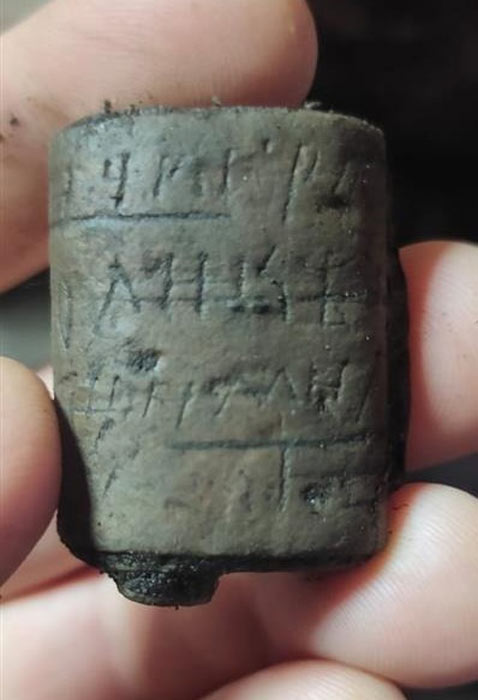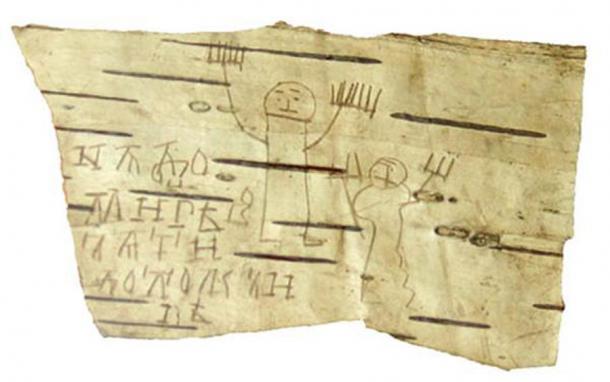Researchers excavating an estate dating back to the 12th and 15th century, have discovered a complete birch bark letter in the historic city center of Vekliky Novgorod in north-western Russia. The letter was well-preserved thanks to the waterlogged clay soil in which it lay since the 12th century and adds to previous knowledge garnered from other birch bark letters found in the area.

The cultural layer of the excavation site where the birch bark letter was found . Institute of Archaeology RAS
Novgorod Birch Bark Letter Finding
During excavations of the wealthy estate, the archaeologists from the Institute of Archaeology of the Russian Academy of Sciences uncovered a variety of artifacts including leather shoes, wooden dishes and ceramic vessels. They also found a 13th century seal of St. John the Theologian and St. Lazarus of Bethany, amongst others.
It was while excavating the 12th century Novgorod cultural layer found at 8 meters deep (25 ft) that they came across this exciting find. Marked 1144, the birch bark letter discusses financial issues related to the payment of services.

Birch bark letter number 1144 . Institute of Archaeology RAS
Past Birch Bark Letter Discoveries
In 2014, Voice of Russia reported that archaeologists had unearthed six ancient Russian birch bark texts in Vekliky Novgorod. At the time, the discovery added to the collection of more than 1,000 birch bark texts which have been immensely significant in changing traditional ideas about literacy rates in ancient Russia, opening a new page in the study of the Russian language, and shedding light on early northern Russian culture.
The first birch bark letter was found on July 26, 1951, by Nina Fedorovna Akulova, and at least 1,025 have been unearthed thereafter – 923 in Novgorod alone – typically dating from the period between late 11th and early 15th century. Almost all of them were written with styluses of bronze and iron, and never ink. The letters were preserved due to the swampy soil which isolated them from oxygen. Many of them are found in streets, because streets were paved with logs, which eventually sank into the soil, with additional layers burying older ones, including the letters.

Birch bark letter no. 497, (c. 1340 – 1390 AD) also discovered in Vekliky Novgorod . ( Public domain )
The ancient city of Novgorod was a key link between Russia and Western Europe, making it one of the most important historic cities in Russia. At its peak during the 14th century, it was one of Europe’s largest cities, with a reported population of 400,000.
Among their authors and addressees of the birch bark documents are priests, high officials, house owners, merchants, stewards, craftsmen, warriors, women, and even children. For example, the document below contains spelling lessons and drawings made by a boy named Onfim, who is estimated to have been between 6 and 7 years old at the time.

Birch bark letter no. 202, mid-13th century, produced by a child . ( Institute of Archaeology RAS )
The Impact of Birch Bark Letter Discoveries
The discovery of birch bark documents penned by people of both sexes, of different ages and of varying social status changed understanding about the literacy rates in northern Russia, suggesting it was far more developed than previously thought. They also shed light on the written language of the time – the texts are written in a peculiar Slavic vernacular, reflecting living speech, and almost entirely free of the heavy Church Slavonic influence seen in the literary language of the period.
Most of the letters deal with everyday usage, business and personal correspondence, such as instructions, complaints, contracts, news, reminders, and study exercises. They touch on family life and household management, trade and finance, crimes and legal proceedings, travel, military expeditions, and various other types of material, all of which reveal an enormous amount of details of medieval northern Russian life.
The newly discovered texts are believed to be of a business nature but are currently undergoing analysis by linguists. According to Heritage Daily , the discovery of birch bark letters “has significantly changed the understanding of the cultural level and language spoken by the East Slavs.”
Top image: Birch bark letter no. 1144 from the 12th century excavation layer. Source: Institute of Archaeology RAS
By April Holloway
 RSS Feed
RSS Feed















 December 29th, 2021
December 29th, 2021  Awake Goy
Awake Goy  Posted in
Posted in  Tags:
Tags: 













